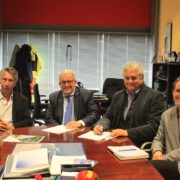Railway connectivity is the key to boosting the Spanish port system
During the month of April the Spanish Ministry of Development (Fomento) requested the EU for funding to help support the transfer of goods from the road to the railway. The Port of Valencia will allocate this investment to the rail connection between Zaragoza and Sagunto, the new line between the ports of Seville and Sines, and the restructuring of SNCF in France.
Statistics published in the fourth month of the year showed that rail freight traffic in Spain has grown 6% in 2017, good news for the sector, although the figures of Renfe Mercancías for February 2018 are not as positive. In this regard, the operator has registered a 17% drop, to which all its traffic except intermodal have contributed.
This fact contrasts with the conclusions reached by the Corell Foundation, which argues that the differences in regulation and costs between the different modes of transport currently prevent a truly competitive and efficient intermodal transport system from being implemented in Spain.
In this regard, the Ministry of Development still awaits the approval of the European Commission to be able to include annual funding worth 25 million euros to facilitate the modal transfer of goods from the road to the railway in the budgets for 2018. Brussels has already given its approval to the subsidies proposed by Sweden, having considered them in accordance with the EU rules on state financing.
On the other hand, CETM Multimodal, Railgrup and Feteia-Oltra have signed an agreement in April to promote innovative projects in the field of multimodal transport.
Port and Railway Connections
Also in Spain, Adif will increase the carrying capacity on the line between Zaragoza, Teruel and Sagunto, a line in which the Port Authority of Valencia plans to invest around 100 million euros, of which one part will be allocated to rail access to Port of Sagunto.
Its objective is to attract more traffic from Aragon, which only uses its facilities to channel 16% of its maritime exports. Currently, the region finds its main outlet in the shores in Catalonia, and it is in the Port of Barcelona where 61% of the rail traffic has Aragón as its origin or destination.
In the south, MSC has already started the service between the ports of Seville and Sines, with a frequency of two round trips per week and a capacity of about 100 TEUs for each one. Meanwhile, in Cádiz, the City Council and the Port Authority have signed an agreement to connect the new container terminal of the port using the railroad.
In addition, in Vigo, the Port Authority and Adif will work on the definition of the project connecting the vehicle terminal with the railway. As for the future line that will link the city with Portugal, it was announced that it will admit the passage of trains of 750 meters.
Changes at the European level
Another neighboring country, France, has been in the news due to the restructuring of the SNCF public railway company, which has caused a wave of mobilizations among the unions for what they consider a privatization of the operator.
The plan involves the recapitalization of the 4,300 million euros debt accumulated by the merchandise subsidiary, to form an independent company, wholly owned by SNCF, but segregated from SNCF Logistics. To finance this whole process, the Gallic government plans to tax heavy vehicles, a measure that has been rejected by transport associations.
Both Spain and France continue to make progress in the implementation of railway motorways along the Atlantic and Mediterranean axes. In fact, the call for expressions of interest addressed to those interested in the exploitation of this type of service has already been officially published.
At the European level, it is worth mentioning the initiative of the Ferrmed Association, which has set up three multisectoral work groups to improve the infrastructure, operation and mobile material in the Trans-European Rail Network to reduce transport costs by more than 25% .
Source: Cadena de Suministro.








 DG-MOVE
DG-MOVE